Dear Friends of the Lower Raritan Watershed –
Five years ago Superstorm Sandy came ashore, causing widespread destruction throughout our region. Now our thoughts go out to Houston, Florida and Puerto Rico as they recover from this season’s ruinous Hurricanes. How would our Lower Raritan Watershed fare if drenched with similar rainfall to that which Hurricane Harvey dumped on Houston? Every one of our watershed communities would be devastated. And if a Hurricane like Maria hit Raritan Bay the storm surge would level Sayreville, South River, South Amboy and much of Perth Amboy. Although rainfall amounts akin to Harvey are extremely unlikely in our region, global climate change is increasing the likelihood and frequency of powerful hurricanes and other storms. The northeast has already experienced a 71% increase between 1958 and 2012 in the amount of rain that falls in very intense storms.
At LRWP we think about and work on climate adaptation in relation to water quality improvements, community health and storm preparedness. Our approach is to identify, prioritize and implement nature-based solutions (called Green Infrastructure) that will make our Lower Raritan Watershed communities resilient to stronger rain storms and rising temperatures. Preparing and adapting proactively will save money while protecting our infrastructure, the environment, and human life – with the added benefits of improved air and water quality, reduced urban heat island impacts and enhanced urban neighborhoods. For this reason we are organizing the November 17 “Green Infrastructure for Resilience” workshop with NOAA. This workshop is designed to help our communities think through their resilience approaches. Registration is now open. We encourage municipalities (Environmental Commissions, Green Teams, Planners, Engineers, Council Members) to attend as teams to develop concept plans to take back to your towns. Continuing education credits are available through the American Planning Association (6 credits) and the Association of State Floodplain Managers (5 credits).
We are very excited to kick off our 3rd (!!) year as a non-profit with the NOAA resilience workshop. We are also rolling out lots of birthday surprises on our websitethroughout October (new resource pages for students, towns, teachers and homeowners) and plenty of other events to get you out in the field!
See you in the watershed,
Heather Fenyk, President
Lower Raritan Watershed Partnership
Article and photos by Joe Sapia
Note: The yard references are to my house in the section of Monroe between Helmetta and Jamesburg in South Middlesex County. My yard is in a Pine Barrens outlier on the Inner Coastal Plain, the soil is loamy, and my neighborhood is on the boundary of Gardening Zones 6b (cooler) and 7a (warmer). Notes and photographs are for the period covered, unless otherwise noted.

Dawn on the Delaware River, looking downstream from Hamilton, Mercer County, to the other side of the river and Bucks County, Pennsylvania.
ABBOTT MARSHLANDS: The Abbott Marshlands are about 3,000 acres, about 1,300 wetlands and 1,700 uplands, along the Delaware River on the boundary of Burlington and Mercer counties in the Bordentown-Trenton area. An interesting point of the marsh is that it is both freshwater and tidal. While Delaware River saltwater going inland ends between the Delaware Memorial Bridge and Philadelphia, the tidal effect continues for miles upstream to the Marshlands. The Marshlands also are known as the Trenton Marsh and the Hamilton Marsh. More information is at http://abbottmarshlands.org/.
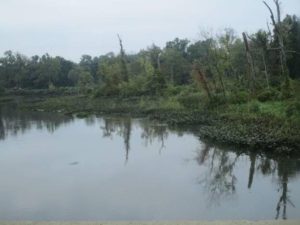
The Abbott Marshlands at Hamilton, Mercer County.
MONARCH BUTTERFLIES: Watch for monarch butterflies, “Danaus plexippus,” on their southern migration, to either Florida or, more likely, Mexico. This “super generation” are the great-grandchildren of last fall’s migrators and will make the complete migration. However, next year, they will begin northward, but will only make it so far, requiring three breedings to complete the journey north. Then, those great-grandchildren will become a “super generation,” making the entire journey south.
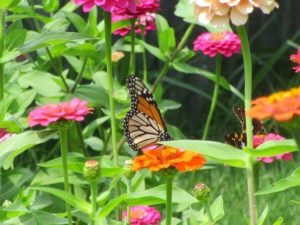
A monarch butterfly in my garden in August.
DRIVE-BY NATURALIST, BLACK VULTURES: I was driving to Princeton, Mercer County, to meet the lovely Pamela for breakfast and came across quite a scene on Route 27 in South Brunswick, Middlesex County – dozens of black vultures, “Coragyps atratus,” feeding on a dead deer. (As I mentioned last month, I do not recall seeing a black vulture locally until probably the 1990s. They are a southern species that has moved north.) Remember, nature is all around us, just keep an eye out for it.
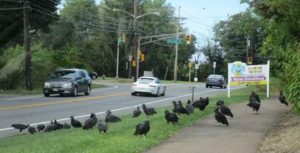
Black vultures on Route 27 in South Brunswick, Middlesex County.
DRIVE-BY NATURALIST, CHESTNUT TREES: As I was driving through the Pine Barrens around Helmetta, I noticed a Middlesex County Parks and Recreation pickup at the Jamesburg Park Conservation Area. I had to talk to naturalist Eric Gehring about a volunteer project, so I turned around and pulled over. Eric was on a mission with Les Nichols of the American Chestnut Foundation, looking for chestnut trees, “Castanea dentata,” in the Conservation Area. Since around 1900, the American chestnut has been plagued by a non-native and extremely invasive and potent fungal blight, “Cryphonectria parasitica,” – estimated to have crippled up to 4 billion chestnuts initially. American Chestnut blight affects the tree upward from where it infects it. The tree, then, is able to sprout again from roots, only to have those shoots, except for rare cases, infected. The Foundation seeks good specimens, hoping to create resistance in future chestnuts. Eric asked if I knew of chestnuts growing in these woods. Yes, at Swing Hill (which Eric already knew about) and at Big Tree. Into the woods, we headed – on my part unexpectedly, but I would rather walk the woods my family has walked for more than 100 years than do chores around the house – looking for specimens that may produce sought-after seeds in the future.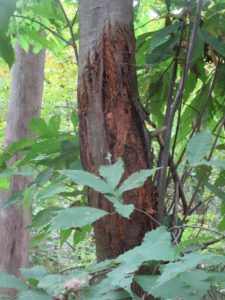
An American chestnut, in the Pine Barrens around Helmetta, infected with the fungal blight.
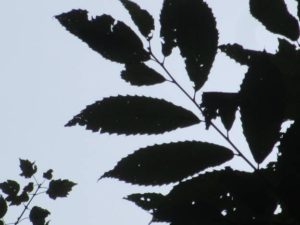
American chestnut leaves in silhouette – serrated with a surf wave-like pattern.
STINK BUGS: I had noticed one or two brown marmorated stink bugs, “Halyomorpha halys,” outside the house. This is an Asian species, apparently introduced accidentally in the Allentown, Pennsylvania, area in 1996. This week, I found one in the house on a blind in my living room — perhaps just the beginning of an infiltration for their overwintering. As a Rutgers University fact sheet says, “They enter houses through cracks in windows and the foundation and may be seen in large numbers during September and October.” If you go after one and, say, crush it, it will release an earthy odor. So, it is a nuisance, not a damaging bug to the house. However, it is a serious threat to crops. More information is available at https://njaes.rutgers.edu/stinkbug/. (As for crickets in the house, my $45,000 cricket deterrent project – that is the remodeling with the side benefit of keeping crickets out of the house – seems to be working. So far, only 8 crickets in the cellar and 2 in the living section of the house. A cacophony of crickets is beautiful music. A single cricket rubbing its legs in the wee hours like the fingernail scratching of a blackboard. While cleaning the garage, I may have discovered their last main intrusion route into the living section – through a crack/opening between garage floor and foundation.)
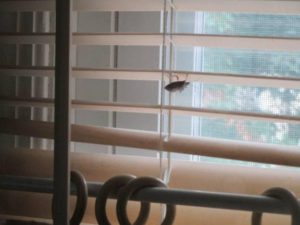
marmorated stink bug on a living room blind.
BIRD FEEDING: This is the first summer in years I have not gone all out feeding the birds in my yard. I miss watching them, but I saved quite a bit of money (because I use only sunflower hearts or kernels) and tried something new, letting the birds eat insects, serving as a natural pesticide. But the bird-feeder is back up and the birds are slowly discovering it. I am looking forward to beginning my day watching birds feed.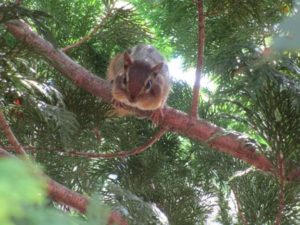
A chipmunk, “Tamias striatus,” in the yard.
FERRIS FARMS: Now that I am feeding the birds in my yard again, I stopped by my regular bird food supplier, Ferris Farms in East Brunswick, Middlesex County. I recall visiting Ferris as a youngster with my family. Mike Rutkowski and Tony Riccobono have always been friendly and helpful when I have asked gardening questions. See http://www.ferrisfarms.org/.
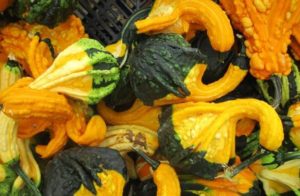
Gourds at Ferris Farms in East Brunswick, Middlesex County.
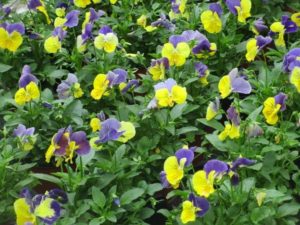
Pansies at Ferris Farms.
KITCHEN TABLE: The flower display on my kitchen table gets better and better. One, the Knock Out roses continued flowering. Two, the zinnias also continued blooming. Three, I learned the display looked better with the more zinnias that I used. Lastly, the gourds were the same as before but they seemed to be yellowing in color, making them more autumn-like. Of course, the antique, porcelain-top table adds to the country-ness of the display. On the down side, this rose bloom seems on its way out. (I have something up my sleeve, though: Grandma Annie Onda’s old kitchen table, with porcelain top and more ornate build, stands ready in my cellar to be moved upstairs to the kitchen.)
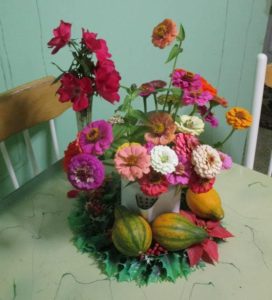
The kitchen table flower display.
ZINNIAS IN THE GARDEN: This week, my zinnias were distributed to the Helmetta Post Office, the lovely Pamela’s, and Jamesburg Dental Care (where I had my first dental appointment 55 years ago under Dr. Lew Goldstein). Butterflies continue to visit my zinnia patch.
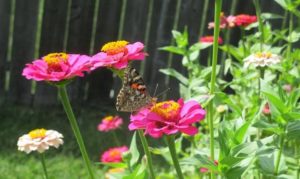
A painted lady, “Vanessa cardui,” in the zinnia patch.
HURRICANE JOSE, THE GOOD: Jose’s effects brought out sightseers to look at the roughness of the ocean. And I saw parasailing surfers taking advantage of the winds at the Atlantic Ocean at Sea Bright, Monmouth County.
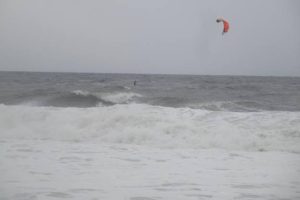
A parasailing surfer in the Atlantic Ocean at Sea Bright, Monmouth County.
WEEDS IN THE YARD: When I see some kind of vegetation popping up in the yard, I let it grow to observe it. So, year after year, pokeweed, “Phytolacca americana,” pops up, one plant along my driveway, another in my garden. Here is an interesting article on this complicated plant, http://nadiasyard.com/our-native-plants/american-pokeweed/.
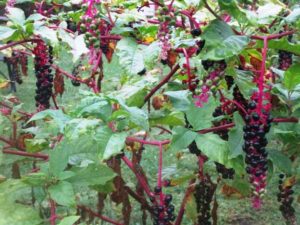
Pokeweed in the garden.
MONMOUTH CONSERVATION FOUNDATION: A shout-out to the Monmouth Conservation Foundation, a not-for-profit land preservation group in Monmouth County, as it celebrates its 40th anniversary. Over the 40 years, it has helped save more than 22,000 acres of open space. (The Foundation recently contracted me to write two articles – one on the group’s origin and another on Monmouth County wildlife — for one of its upcoming publications.)
OCEAN TEMPERATURES: Atlantic Ocean temperatures on the New Jersey coast were about 69 degrees to 74 degrees on the weekend of September 23-24.
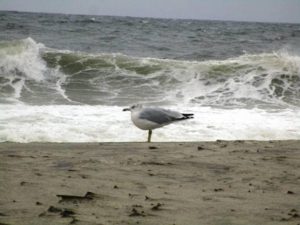
A gull at the Atlantic Ocean beach at Sea Bright, Monmouth County.
SUNRISE/SUNSET: For September 24, Sunday, to September 30, Saturday, the sun will rise about 6:50 a.m. and set about 6:45 p.m. For October 1, Sunday, to October 7, Saturday, the sun will rise about 6:55 to 7 a.m. and set about 6:30 to 6:40 p.m.
THE NIGHT SKY: The next full moon is the Full Harvest Moon October 5, Thursday.
WEATHER: The National Weather Service forecasting station for the area is at http://www.weather.gov/phi/.
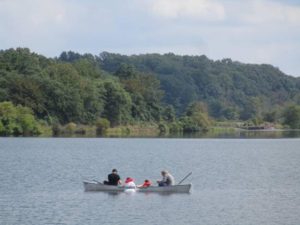
“Jamesburg Lake,” or more properly “Lake Manalapan,” on the boundary of Monroe and Jamesburg, Middlesex County, is about 35 to 40 acres. On the Outer and Inner Coastal Plains, there are few, if any, natural bodies of water. So, Jamesburg Lake on the Inner Coastal Plain is formed by the damming of Manalapan Brook.
Joe Sapia, 60, is a lifelong Monroe resident. He is a Pine Barrens naturalist and an organic vegetable-fruit gardener. He gardens the same backyard plot as did his Italian-American father, Joe Sr., and his Polish-immigrant, maternal grandmother, Annie Poznanski Onda. Both are inspirations for his food gardening. Joe is active with the Rutgers University Master Gardeners/Middlesex County program. He draws inspiration on the Pine Barrens around Helmetta from his mother, Sophie Onda Sapia, who lived her whole life in these Pines, and his Grandma Annie. Joe’s work also is at @JosephSapia on Twitter.com, along with Facebook.com on the Jersey Midlands page.
Article and maps by Sophie Benaroya, Rutgers University Sophomore
This summer I worked in Dr. JeanMarie Hartman’s Lab at Rutgers University researching factors that affect infiltration rates. More specifically I looked into how soil health indicators compare with infiltration rates in New Jersey’s Lower Raritan Watershed.
Soil health and infiltration rates are important because of their wide-reaching effects. Soil health affects groundwater, surface runoff (and hence flooding), and vegetative productivity. Unhealthy soil can lead to contaminated groundwater and waterways, a decrease in arable land, a decrease in forests and an increase in flooding risk. There are many factors that affect soil health, infiltration being one of them. Soil can be impacted by organic matter content (animal and plant matter in various stages of decomposition), soil fragments (rock fragments larger than a grain of sand) and amount of impervious surface – like roads, pavements and parking lots, and land use. Previous research has shown that urbanization has a major impact on soil health, and due the fact that the Lower Raritan Watershed is mostly urban land I felt it would be interesting to see how urbanization may have affected the soil.
To research the topic, data was downloaded from the Web Soil Survey, the official source of soil data for the United States. I analyzed these data using ArcGIS, a mapping software, and Microsoft Excel. Data on various chemical, physical and water properties on soil in the Lower Raritan Watershed was downloaded and compared to infiltration rates. As there is no data on infiltration as is; saturated hydraulic conductivity and hydrological soil groups were used as surrogates (this decision was based on the recommendations of professionals in the field). The factors that were researched were organic matter content, percentage of fragments in soil, bulk density (how compact the soil is), surface runoff class (the amount of water flow on land and is not absorbed into the soil), impervious surface cover, and land use.
First, I compared saturated hydraulic conductivity and land use. This comparison, as well as the tabular data, showed that urban areas have lower saturated hydraulic conductivity levels than Forest, Wetland and Agricultural areas.
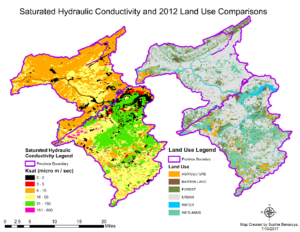
Figure 1: Saturated Hydraulic Conductivity and Land Use Comparisons
Then I compared hydrological soil groups with soil fragments percentages in the soils (Figure 2, below). Hydrological Soil Groups are groups that soil is placed in based on its surface runoff class, saturated hydraulic conductivity, and infiltrometer data. There are five classes as follows: A – High infiltration, B – Moderate infiltration, C – Slow infiltration, D – Very slow infiltration, and A/D, B/D, C/D – Dual soil groups (first letter represents drained areas, second letter represents un-drained areas.) It is evident from the map that soils with a percentage of fragments of 28% and above generally fall under soil group “D”, further insight into tabular data showed that 58.39% of soil in group D have over 28% fragments. Soil groups A and B had the majority of their soils have 6% or less fragments.

Figure 2: Hydrological Soil Groups versus Soil Fragments %
I then looked at saturated hydraulic conductivity versus surface runoff class comparisons. In this analysis (see Figure 3 below) I compared the relationship between saturated hydraulic conductivity and surface runoff class. Saturated hydraulic conductivity is very high (51-150 micro meters/sec) in soils with negligible, very low and low surface runoff. The medium level of hydraulic saturated conductivity is generally lower in the medium, high and very high classes.
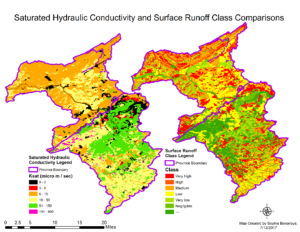
Figure 3: Saturated Hydraulic Conductivity versus Surface Runoff Class Comparisons
Then I looked at saturated hydraulic conductivity and impervious surface percentage comparisons.
Figure 4 below compares the relationship between saturated hydraulic conductivity and impervious surface percentage. As impervious surface increases, high rates of conductivity (6-15 and 51-150 micro meters/sec) decrease in frequency.
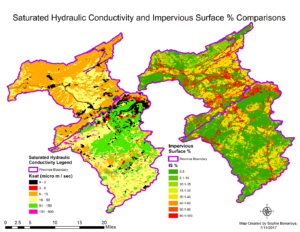
Figure 4: Saturated Hydraulic Conductivity and Impervious Surface % Comparisons
Finally I looked at the breakdown of impervious surface percentage in natural, hydric and urban soils. Figure 5 below shows that over 98% of both hydric and natural soils have 0-5% impervious surface, compared with only 13.51% of urban soils.
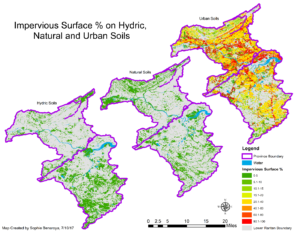
Figure 5: Impervious Surface % on Hydric, Natural and Urban Soils
Through my research I found that unfavorable levels of indicators were linked to lower levels of infiltration. The most interesting finding was the effect of land use on soil health. Urban land had lower infiltration rates than forests, wetlands and agricultural areas. In addition, urban lands had low levels of organic matter, high levels of soil fragments and, high levels of impervious surface. The increase in impervious surface is linked to urbanization. Natural and hydric soils in the Lower Raritan Watershed had less than 5% of their soils exhibit impervious surface cover of 5% or more, compared to almost 75% of urban soils. However, not all urban land uses had the same levels. Athletic fields, recreational land and cemeteries had higher levels of infiltration than military or industrial land; possible because they have more vegetation.
Another important finding had to do with forests. Forests and wetlands have high infiltration rates, however in the Piedmont province there is more fragmentation and as such those forests and wetlands typically have lower levels of infiltration than forests and wetlands in the Coastal Plains province. This means that an increase in the fragmentation of forests potentially due to urbanization would be detrimental to soil health, as forests in the Piedmont have an average saturated hydraulic conductivity rate of 18.52, whilst forests in the Coastal Plains province have an average of 53.21.
The main take-aways from my research is that protection of forested areas could help prevent soils from worsening, and an increase in planting in and around current forest areas could help improve the soil of current patches. An increase in green infrastructure could also be beneficial in improving urban soils by increasing the vegetative cover, organic matter and reducing surface runoff.
Article and photos by Joe Sapia
Note: The yard references are to my house in the section of Monroe between Helmetta and Jamesburg in South Middlesex County. My yard is in a Pine Barrens outlier on the Inner Coastal Plain, the soil is loamy, and my neighborhood is on the boundary of Gardening Zones 6b (cooler) and 7a (warmer). Notes and photographs are for the period covered, unless otherwise noted.
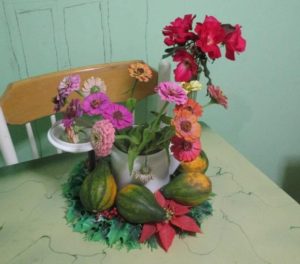
My kitchen table display gets better and better: Gourds, which mysteriously appeared in the garden, are added to the display of zinnias and Knock Out roses on the antique porcelain-top table.
BIG SKY COUNTRY, EMLEY’S HILL: I was driving through one of my favorite places in the Midlands, rural Western Monmouth County. I stopped at Upper Freehold’s Emley’s Hill, part of the cuesta geological formation that divides the Outer and Inner Coastal Plains. Generally, east of this hilly formation drains directly to the Atlantic Ocean, while west of the cuesta drains to the Raritan River. Emley Hill, though, is on a spur of the cuesta dividing the drainages of the Raritan River and the Delaware River. Because it is a hilly rural area at about 140 feet above sea level with lower surrounding farmland, there are beautiful big-sky views. Emley’s Hill is at the intersection of Emley’s Hill Road and Burlington Path Road.
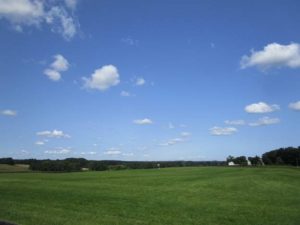
Looking east from Emley’s Hill in Upper Freehold, Monmouth County.
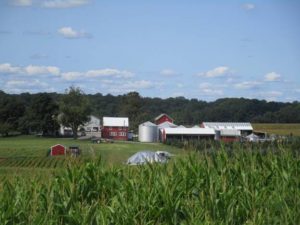
Looking north from Emley’s Hill at the Bullock Farms, http://www.bullockfarms.com/.
WILD OUTDOOR EXPO: The New Jersey Wild Outdoor Expo is an annual event, held at the Colliers Mills Wildlife Management Area in Ocean County. It includes information on environmental issues and parks, hunting, fishing, trapping, other recreational use of the outdoors, and so on.
This year’s expo, held on Saturday and Sunday, September 9 and 10, was sponsored by the state Department of Environmental Protection’s Division of Fish and Wildlife, Division of Parks and Forestry, and Forestry Services, along with the Conserve Wildlife Foundation of New Jersey.
Colliers Mills WMA is the almost 13,000 acres of open space — Pine Barrens forest, fields, waterways, and bodies of water — behind the Six Flags/Great Adventure amusement area. Outside of New Jersey, WMAs are referred to as “game lands.” In New Jersey, WMAs are shared by hunters and other recreational outdoors people.
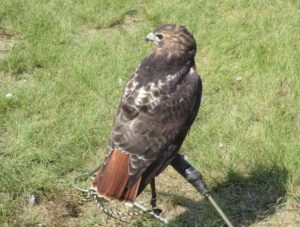
Red-tailed hawk, “Buteo jamaicensis,” on display at the Expo. Note the reddish tail giving the hawk its name. Red tails are commonly seen, soaring above, or commonly heard, calling in a wheezy-sound way.
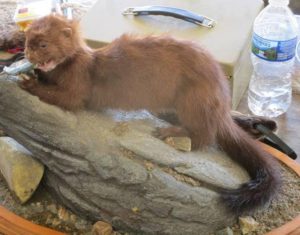
A mounted mink, “Mustela vison.” They are around, but the only two I have seen were both roadkills in recent years in the Pine Barrens around Helmetta.
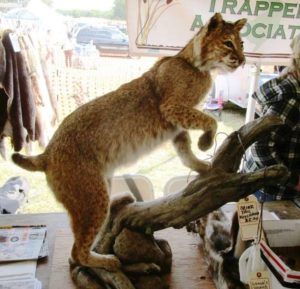
A mounted bobcat, “Lynx rufus.” I describe them as having a dog-like body with a cat’s head. I would love to see one in the wild. The state lists the bobcat as “endangered,” or in immediate peril of surviving.
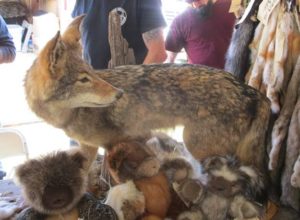
A mounted coyote, “Canis latrans.” Note the dog-like body, but pointy fox-like nose and ears. From 2014 to 2016, I worked an overnight shift near the Metropark train station in Woodbridge, Middlesex County, and I would occasionally see a coyote. One night, an ambulance was on the other side of the woods, yipping its siren. The coyotes started up, yipping away. Smart animals – I once read a suggestion if coyotes had opposing toes, they probably would run the world.
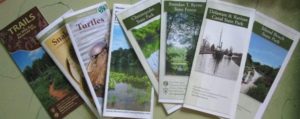
Brochures from the Expo.
FALLING ACORNS: I was driving one of the paved roads through the Jamesburg Park Conservation Area in the Pine Barrens around Helmetta and came across outdoorsman Art Utter, who lives nearby in Spotswood. Art was gathering acorns to use as hunting bait around his deerstand. While we were talking, I was listening to and dodging falling acorns. Earlier, Art got conked on the head by one and it drew blood. These things looked massive. Some might say these acorns suggest a severe winter ahead, with the acorns providing animals with food. I do not think it is a good predictor of anything. The only thing I got out of it was that it seemed as though acorns were falling steadily and they were big.
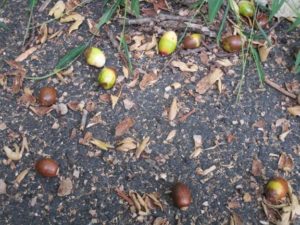
Acorns litter a road in the Jamesburg Park Conservation Area in the Pine Barrens around Helmetta.
IN THE GARDEN: I got tired of looking at the tangle of cucumber and cantaloupe plants that did not produce one usable item this year. So, I mowed them down, along with the tomatillos and gourds, both of which I did not plant. So, now, I look forward to fall lettuce, which is growing nicely, and carrots.
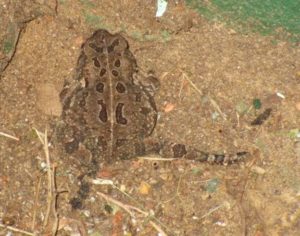
I came across this toad, genus “Anaxyrus,” while cutting the lawn.
THE FLOWERING YARD: The zinnias and Knock Out roses continue to bloom, although the zinnias may have slowed down – perhaps because of powdery mildew and leaf spot. But the Knock Outs seem to be flourishing.
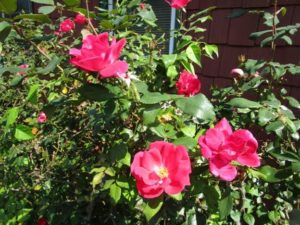
Knock Out roses continue to bloom nicely – even flourishing.
OUT-OF-SEASON FLOWERING: Occasionally, plants bloom out of season. In the past, I remember seeing sheep laurel, “Kalmia angustifolia,” blooming in the fall in the Pine Barrens around Helmetta, when its normal bloom is May and June. Maybe an out-of-season bloom was caused by temperatures and sunlight replicating normal bloom times. Whatever the reason, the flowering quince bush in my yard was actually flowering. Normal flowering would be in the spring.
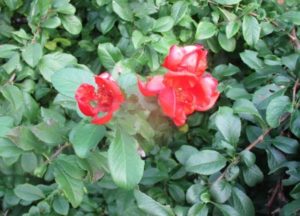
Flowering quince blooming out of season.
BIZARRE EXPERIENCE IN THE YARD: The flowering quince was unusual, but not bizarre. The bizarre experience happened a day earlier, when I was cutting the front yard grass. First, I notice a rabbit, “Sylvilagus floridanus,” watching me from a few feet away on the other side of the hedges. As I have mentioned, if I go about my own business, the rabbits and butterflies allow me to get close. As I was cutting the grass along the street’s edge, I noticed something embedded in the ground where I had just mowed – a 20-gauge, loaded shotgun shell! If I cut that open when I was mowing, I could have sprayed hundreds of pellets. Fortunately, it was intact, but bent, probably having been run over by a vehicle. In the old days, I could have asked any of a number of hunters in the neighborhood what to do. But hunting is becoming less popular, so less available sources. Although it was probably remote I could set off the primer and powder, I did not want to take a chance. So, I called Monroe Police and gave it to responding Officer Bob Bennett with whom I had a great conversation about the local woods. (Officer Bennett opened the conversation, asking if I was the guy…. Uh, oh, a police officer asking if I was the guy! Actually, he asked if I was the guy who posts nature photographs on the local Facebook page. Guilty, Officer. I mean, Yes, Officer.) As for the shotgun shell, who knows where it came from. My friend, the rabbit, disappeared. Was it warning me about the shell?
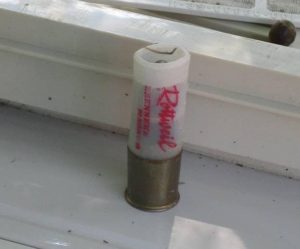
The shotgun shell.
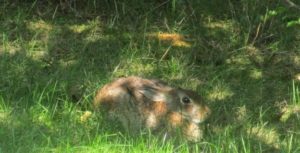
My rabbit friend. Was it warning me about the shotgun shell?
FLOWERING HIGHTSTOWN: One of my regular stops is the Hightstown Diner, where Kathy and George Antonellos have been great hosts over the decades in their 1941 diner. What I notice when I visit the diner is the flowers in this quaint, historic Mercer County town. So, I walked about, shooting photos of them. (If you like South Jersey-Philadelphia scrapple, the Hightstown Diner has it – one of the northernmost locations where scrapple can be found. Me, I love scrapple!)
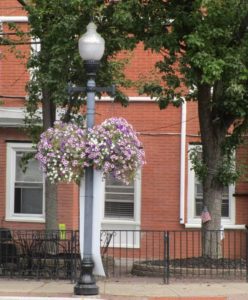
The corner of Mercer Street (Route 33) and Rogers Avenue in Hightstown, Mercer County.
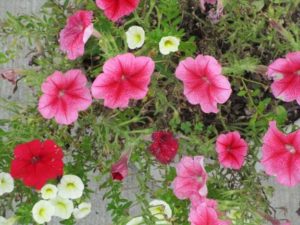
Along Mercer Street (Route 33) in Hightstown, Mercer County.
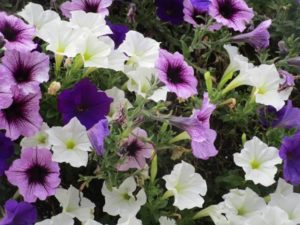
Flowering Hightstown.
DRIVE-BY NATURALIST, A GREAT EGRET: As I was driving home from Hightstown, I crossed the Millstone River, the boundary of East Windsor, Mercer County, and Cranbury, Middlesex County. There, I noticed a perched great egret, “Ardea alba.” Keep an eye out for nature. It is all around us.
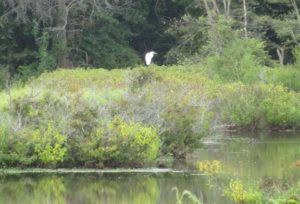
A great egret on the Millstone River. Here, the river is the boundary of East Windsor, Mercer County, and Cranbury, Middlesex County.
OCEAN TEMPERATURES: Atlantic Ocean temperatures on the New Jersey coast were about 72 degrees Friday, September 15.
SUNRISE/SUNSET: For September 17, Sunday, to September 23, Saturday, the sun will rise about 6:40 to 6:45 and set about 6:55 to 7:05. The fall equinox of nearly equal daylight and sunlight is September 22, Friday. For September 24, Sunday, to September 30, Saturday, the sun will rise about 6:50 a.m. and set about 6:45 p.m.
THE NIGHT SKY: The new moon is September 20, Wednesday. The next full moon is the Full Harvest Moon October 5, Thursday.
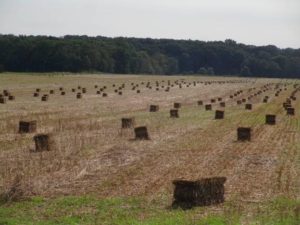
Harvest time it is. Here, hay being harvested on a farm in Cranbury, Middlesex County.
WEATHER: The National Weather Service forecasting station for the area is at http://www.weather.gov/phi/.
Joe Sapia, 60, is a lifelong Monroe resident. He is a Pine Barrens naturalist and an organic vegetable-fruit gardener. He gardens the same backyard plot as did his Italian-American father, Joe Sr., and his Polish-immigrant, maternal grandmother, Annie Poznanski Onda. Both are inspirations for his food gardening. Joe is active with the Rutgers University Master Gardeners/Middlesex County program. He draws inspiration on the Pine Barrens around Helmetta from his mother, Sophie Onda Sapia, who lived her whole life in these Pines, and his Grandma Annie. Joe’s work also is at @JosephSapia on Twitter.com, along with Facebook.com on the Jersey Midlands page.
Article and photos by Joe Sapia
Note: The yard references are to my house in the section of Monroe between Helmetta and Jamesburg in South Middlesex County. My yard is in a Pine Barrens outlier on the Inner Coastal Plain, the soil is loamy, and my neighborhood is on the boundary of Gardening Zones 6b (cooler) and 7a (warmer). Notes and photographs are for the period covered, unless otherwise noted.
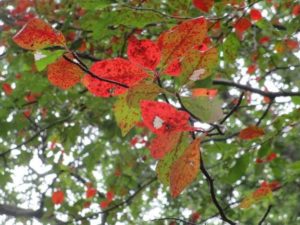 A black gum, “Nyssa sylvattica,” changes color at Cranberry Bog in the Pine Barrens around Helmetta.
A black gum, “Nyssa sylvattica,” changes color at Cranberry Bog in the Pine Barrens around Helmetta.
CHANGING COLORS IN THE PINE BARRENS AROUND HELMETTA: Black gum trees, ““Nyssa sylvattica,” are obvious with their leaves changing colors for the season. “Fall foliage,” meaning the changing colors as colder weather approaches, is a misnomer, because, here, in the Pine Barrens around Helmetta, changing colors are noticeable beginning about July 15 to 31. I look for the peak of the coloring October 13 in wet areas and October 20 in dry areas, but, really, it is impossible to pinpoint a peak. If there is even a peak, because there may not be a uniform turning of colors.
“OPIENKI” MUSHROOMS, PINE BARRENS AROUND HELMETTA: As I drove a paved road through Jamesburg Park today, I saw a car parked at the woods and a woman at the car. She wore yoga pants, a short-sleeve pullover shirt, and sneakers, pants untucked — not really dressed as a woodswoman. So, I took a guess at what she was doing.
Mushrooms? I asked.
She said yes.
What kind, honey mushrooms?, I said.
The woman — Lana, who lived a few miles away from the site — said she did not know the name to tell me. Then, I noticed what sounded to be an Eastern European accent.
“Opienki”? I asked.
Yes, she smiled. How did you know that name?
A grandmother from Poland, I said.
Lana is from the Ukraine. She was picking edible mushrooms of the genus “Armillaria,” known by Polish people as “opienka” singular and “opienki” plural. “Pien” means stump in Polish and these mushrooms grow along the stumps of dead oaks. Hence, they also are known as “stumpies” — and “tan and yellow stumpies” because of their color and, of course, where they are found. But the general public probably would know them best by their common name, “honey mushrooms.”
Lana had bags filled with mushrooms in her car. (See the photos, which she let me take.)
Journalisticly, I am publishing this to inform people. In a neighborly way, I am hesitant to publish this because PICK THE WRONG MUSHROOM AND, AT BEST, YOU WILL GET SICK, AND, AT WORST, YOU WILL DIE.
I am 60-years-old and have been in these woods my whole life, and have heard stories from them going back another 50 or 60 years to when my maternal family settled here, and I will confidently pick ONLY ONE mushroom in the Pine Barrens around Helmetta: opienka. In the Jersey Midlands as a whole, I will confidently pick ONLY TWO: the second one, a morel, which I am familiar with on the Piedmont — say, at such areas as Princeton and Sourland Mountain.
I am “somewhat confident” to pick two more. But I made it to 60 and “somewhat confident” does not cut it. Remember the adage: There are bold mushroom pickers and there are old mushroom pickers. There are no old AND bold mushroom pickers.
If one must pick mushrooms, three bits of advice, even for the experienced picker: One, know how to call emergency responders, telephone 911; two, the telephone number of New Jersey Poison Control, 800-222-1222; and three, save one mushroom, perhaps on your kitchen counter, so doctors know the mushroom one ate.
I said good-bye to Lana, warning her of ticks, which can pass along disease such as Lyme, and chiggers, which will get one itching, beginning about 36 hours after leaving the woods, and scratching like crazy for days. (Me, man who got chiggers a week ago, here, in the Pine Barrens around Helmetta. Me, stupid man because I was not thinking and did not avoid grassy areas.)
(Dedicated to Grandma Annie Poznanski Onda, born 1885 in Poland, died 1972 in the Pine Barrens around Helmetta. And a big thank you to Ralph “Rusty” Richards, woodsman extraordinaire of the Pine Barrens around Helmetta, who continues to be a local woods mentor to me.)
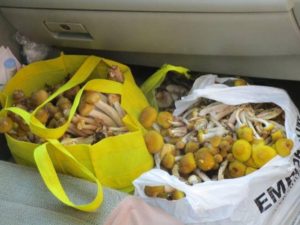
Lana’s “opienki” mushrooms in the Pine Barrens around Helmetta.
ALSO IN THE PINE BARRENS AROUND HELMETTA: Look for fall bloomers, such as asters. Joe Pye weed, “Eutrochium purpureum,” remains blooming – and will do so until about October. Queen Anne’s lace, “Daucus carota,” continues blooming to about November. The seed heads of punks, or cat-tails, genus “Typha,” were fluffing as summer passes.
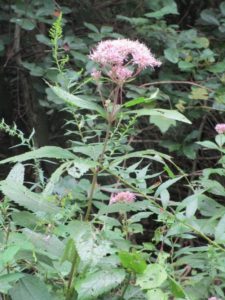
Joe Pye weed in bloom near the Ditch in the Pine Barrens around Helmetta.
CHIGGERS IN THE PINE BARRENS AROUND HELMETTA: I did a brief hike Friday, Sept. 1, and began itching around Sunday morning – chigger bites! Fortunately, I did not get a bad case, a bit of itching here and there on my legs. I first encountered chiggers, here, in about 2004. Some view chiggers as a Southern species moving north; Others will say we already had them up here. I knew of chiggers from hiking in the Pine Barrens down in South Jersey. The bottom line is they itch! So, I will scratch for a few days, then life will go on until the next round of chiggers. (A tip: Avoid grassy areas such as those I walked in on my hike. I just was not thinking.)
MA, GRANDPA, AND THE LOCAL PINE BARRENS: Perhaps I was not thinking of chiggers on Sept. 1 because my mind was elsewhere. Earlier that day, I had mailed in a donation to my church, Holy Trinity Roman Catholic Church in Helmetta, and a request for a Mass to be said in Grandpa Mike Onda’s honor October 11– the 100th anniversary of his death in Helmetta from tuberculosis at 35–years-old. He left a 32-year-old widow, Annie Poznanski Onda, and three children 5-years-old and younger. One of those children was my mother, Sophie Onda Sapia, who was 3 when her father died. Her only memory of her father in later years was of her with him at Shekiro’s Pond in Helmetta. September 1 was the 22nd anniversary of Ma’s death at 81 in 1995. On this anniversary, I visited Shekiro’s Pond.
PESTS IN THE YARD: Neighbor Tom DeRose contacted me on the night of Labor Day, wanting to show me something in his yard. So, in the dark with flashlights, Tom and I were looking into a hole – perhaps big enough to shove in a few golf balls – of yellow jacket wasps. Ugh! They have scared me since I was a kid playing Army in this same neighborhood with Eddie Kasubinski. I pointed down the street at “The Swamp,” where Eddie and I got attacked – not by an opposing army, but by “yellow jacks.” I ran up the street crying. My father heard me, rushed into the backyard, saw the yellow jacks attacking me, grabbed my Army jacket, which had yellow jacks in it, and threw it aside. A number flew out of the jacket. I had got stung twice. Yellow jacks can be aggressive and multiple stingers. So, I advised Tom to stay away from his side yard until the cold weather sets in or spray a pesticide into the hole.
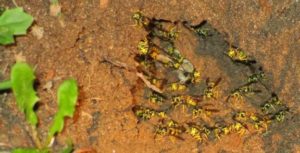
The yellow jacket nest in Tom DeRose and Trisha Miller DeRose’s side yard.
LAURINO FARMS: I was out in Monmouth County and stopped by Laurino Farms on Route 537 (between Laird and Swimming River Roads) in Colts Neck. There, I picked up a favorite of mine, white peaches, along with a jar of cranberry preserves. A shout out to Bobby Laurino, whom I saw briefly – personally, Bobby has patiently answered my gardening questions and he is an inspiration for me growing zinnias this year. And, more importantly, a shout out to Bobby for what he does for feeding the needy, including helping the Soul Kitchen restaurants (www.jbjsoulkitchen.org) in Red Bank and Toms River, founded by rock and roll star Jon Bon Jovi and his wife, Dorothea Bongiovi, who live in Middletown, Monmouth County, to support the needy. For example, Laurino provides space at his farm for Soul Kitchen to grow food organically. Dorothea said, “Bobby is an amazingly generous person, not only with his contribution of land to the Soul Kitchen so we could raise our own vegetables, (but) he is generous with his time, his knowledge, his spirit. I am not sure if all farmers are as optimistic as Bobby, but he has a positive can-do attitude that maybe all farmers need. Farming is an unbelievably difficult life, with many uncontrollable variables: temperature, rain, sun, insects (Bobby does not use pesticides), animals. I have enormous respect for anyone who grows food for others.” (And a shout out to Dorothea, who handles herself with class and humility. Over the summer, Dorothea received a Volunteer Leadership Award in the New Jersey State Governor’s Jefferson Awards for Public Service for her work with Soul Kitchen. “I was very surprised and humbled by the Jefferson award,” Dorothea said.)
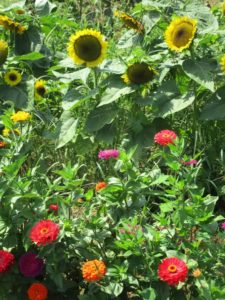
Zinnias and sunflowers at Laurino Farms in Colts Neck, Monmouth County.
DRIVE-BY NATURALIST, “BIDENS” FLOWERS: Although I know the yellow flowers of the genus “Bidens” are adorning unplowed farmland and disturbed areas, it still amazes me when I come across fields of these flowers. I was driving in southern Monroe and came across this batch, next to acres of soybeans.
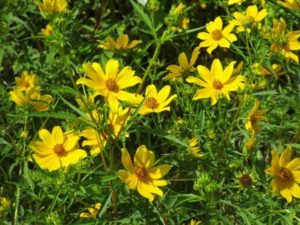
Yellow flowers of the genus “Bidens” in southern Monroe.
IN THE YARD AND GARDEN: The zinnias and Knock Out roses continue to bloom earnestly.
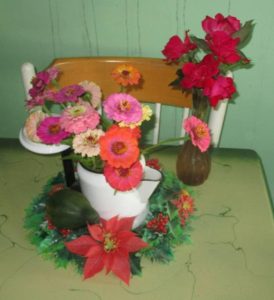
Zinnias, Knock Out roses, and a gourd, all from the my yard or garden, decorate the antique porcelain-top table in my kitchen. One of Ma’s old coffeepots is used as a vase.
MY BELOVED ZINNIAS: While still flowering wonderfully, the zinnias appear to have contracted powdery mildew. So, I will be dealing with this.
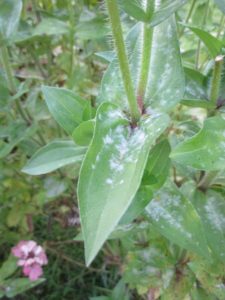
Apparently powdery mildew on the zinnias.
IN THE GARDEN: My summer crop, except for the zinnias, was a disaster. The sweet corn was undeveloped, probably because of too much rain and I should have planted in a bigger block to foster pollination, but it was harvestable and tasty. Too much rain translated into no cucumbers, no cantaloupe. Very few tomatoes, because something ate the tops off the plants.
MECHKOWSKI FARM: Timmy Mechkowski farms in Helmetta. He reported good crops of sweet corn, beets, stringbeans, carrots, broccoli, cabbage, and onions. “Tomatoes were decent until the end, when we starting getting the rain.” Timmy reported a bad year for peppers, potatoes, and blackberries. The Mechkowski farm is one of my favorite places.

Sitting on the front porch of his house, Timmy Mechkowski goes over his planting list.

Timmy Mechkowski’s dog, Abby, probably the most beautiful and most gentle dog I have ever met.
NAVESINK RIVER: The Navesink River drains about 95 square miles in the Red Bank area of Monmouth County. It abuts the hilly geological formation that separates the Inner and Outer Coastal Plains. The river sits on the Outer Coastal Plain side. These photos were taken downstream of the Ocean Bridge from the Middletown side. The bridge connects Middletown and Rumson. The Navesink River is one of my favorite places in the Jersey Midlands.
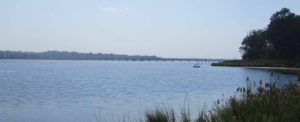
On the Navesink River, looking toward the Oceanic Bridge connecting Rumson, left, and Middletown, right.
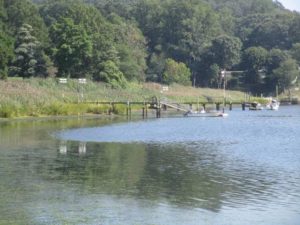
Along the Navesink River.
DRIVE-BY NATURALIST, GREAT BLUE HERON: As I was leaving the Navesink River, I noticed a great blue heron, “Ardea Herodias” – a large bird I am in awe of.
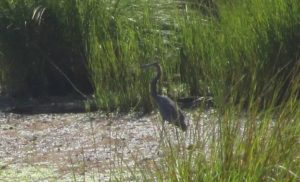
The great blue heron along the Navesink River.
BIG SKY COUNTRY, MONROE TOWNSHIP: As the Jersey Midlands continue to develop, there is more a loss of big sky views. But the area between the Applegarth and Wyckoff’s Mills sections of Monroe is still a holdout. Here, there are wonderful views over soy bean fields and cornfields.
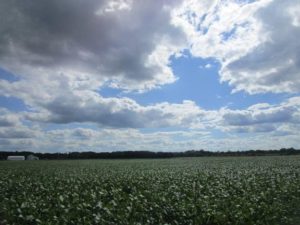
Between Monroe’s Applegarth and Wyckoff’s Mills sections, looking over a soybean field toward Route 33.

Between Monroe’s Applegarth and Wyckoff’s Mills sections, looking toward Cranbury, with corn growing to the right and soybeans to the left.
THE FLIP SIDE OF BAMBI: I have published photographs of beautiful deer in nature. I need to point out the flip side: deer on farmland and in garden. Years ago, I was talking to a farmer who grew corn on the state’s Assunpink Wildlife Management Area in western Monmouth County. The farmer paid no rent, but he had to leave a percentage of his crop to feed wildlife. The way I recall the story: “The problem is,” the farmer said, “the deer don’t know which 75 percent is mine and which 25 percent is theirs.” As Jersey Midlands nature writer John McPhee has written, “Deer, in my opinion, are rats with antlers, roaches with split hooves, denizens of the dark primeval suburbs. Deer intensely suggest New Jersey.”
OCEAN TEMPERATURES: Atlantic Ocean temperatures on the New Jersey coast were in the range of about 69 to 72 degrees during the weekend of September 9-10.
SUNRISE/SUNSET: For September 10, Sunday, to September 16, Saturday, the sun will rise about 6:35 to 6:40 a.m. and set about 7:10. For September 17, Sunday, to September 23, Saturday, the sun will rise about 6:40 to 6:45 and set about 6:55 to 7:05. The fall equinox of nearly equal daylight and sunlight is September 22, Friday.
THE NIGHT SKY: This week, in the pre-sunrise sky, I saw the constellation Orion for the first time this season – Colder weather is coming with the winter constellations. The moon is waning after the September 6 full moon. The new moon is September 20, Wednesday. The next full moon is the Full Harvest Moon October 5, Thursday.
WEATHER: The National Weather Service forecasting station for the area is at http://www.weather.gov/phi/.
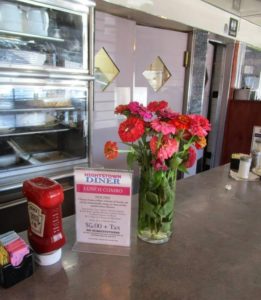
Joey’s zinnias at the Hightstown Diner, in Hightstown, Mercer County.
Joe Sapia, 60, is a lifelong Monroe resident. He is a Pine Barrens naturalist and an organic vegetable-fruit gardener. He gardens the same backyard plot as did his Italian-American father, Joe Sr., and his Polish-immigrant, maternal grandmother, Annie Poznanski Onda. Both are inspirations for his food gardening. Joe is active with the Rutgers University Master Gardeners/Middlesex County program. He draws inspiration on the Pine Barrens around Helmetta from his mother, Sophie Onda Sapia, who lived her whole life in these Pines, and his Grandma Annie. Joe’s work also is at @JosephSapia on Twitter.com, along with Facebook.com on the Jersey Midlands page.
Article and drawing by Maya Fenyk, age 13
Hello! I am Lynx Rufus, but you can call me Blossom the Bobcat. I am New Jersey’s only native wildcat, and have been on New Jersey’s endangered species list since 1991. Sightings of me in the Lower Raritan Watershed and throughout the state are increasing, but are still rare.
You might think “Oh, bobcats must survive just fine. They are at the top of the food chain. They have no predators.” I am sorry to say, that’s just not true. Some of my predators are mountain lions, coyotes, foxes, owls, wolves and humans. I can’t say I blame them as I also prefer a carnivorous diet. My prey includes rabbits, rats, squirrels, ground-nesting birds, turkeys and even small or sick deer. But predator threats are not my biggest concern.
My species used to be abundant and flourishing in the coniferous and mixed forests of New Jersey until humans started deforesting our homes. Clearing land for retail, corporate and housing developments has a huge impact on my survival. And disruption of our habitat by pipelines has huge impacts on us and other endangered, threatened and special concern species. Other issues that affect me are hunting and being hit by cars. Getting hit by cars, development and pipeline installation are linked. Fragmentation of my habitat makes it hard for me to find shelter from the weather, cover for hunting and raising my babies, and forces me and my family to cross roads to find our dinner and safe spaces to hide. Please slow down through forested areas! When humans ruin my home, push me onto their roads, and drive too fast through the woods it really gets my angry purring going.
The New Jersey Department of Environmental Protection’s Endangered and Nongame Species Program’s Bobcat Recovery and The Nature Conservancy’s Bobcat Alley are both doing a great job restoring bobcats in New Jersey, but plans for pipelines and proposals to reduce protections under the state’s Freshwater Wetlands Protection Act and the federal Clean Water Act put our population recovery into question.
I must head to my den to check on my kittens, but I want to let you humans know how important it is to keep track of the numbers of my species. To report a bobcat or other endangered species sighting, please contact NJDEP. Thanks! And I say that with a final meow!
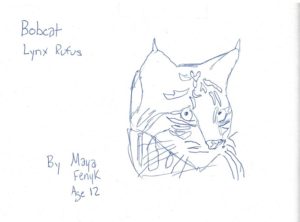
Article and photos by Joe Sapia
Note: The yard references are to my house in the section of Monroe between Helmetta and Jamesburg in South Middlesex County. My yard is in a Pine Barrens outlier on the Inner Coastal Plain, the soil is loamy, and my neighborhood is on the boundary of Gardening Zones 6b (cooler) and 7a (warmer). Notes and photographs are for the period covered, unless otherwise noted.
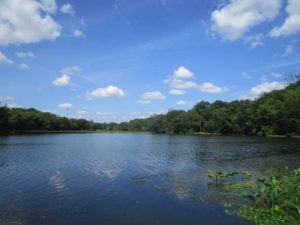
Etra Lake, in East Windsor, Mercer County, sits on the Inner Coastal Plain. Most, if not all, bodies of water on New Jersey’s Inner and Outer Coastal Plains, are human-made – in Etra Lake’s case by the damming of Rocky Brook. Rocky Brook is part of the Raritan River-Bay watershed. The damming of the lake appears to go back to the late 1700s to create a power source to run a grist mill. The name “Etra” actually is an acronym, “ETRA,” after a prominent resident, Edward Taylor Rosel Applegate, born in 1831 and died in 1915.
THE CUESTA: Of New Jersey’s four land regions, two are in the Jersey Midlands – the rolling terrain of the Piedmont and the generally flat Coastal Plain. The Coastal Plain can be broken down further – the Outer and Inner. What people may not realize is the Coastal Plains are divided by an on-again, off-again hill system – the cuesta. The cuesta essentially runs from Sandy Hook in the northeast to the Philadelphia area in the southwest. It can easily be traced on a map through place names, from northeast to southwest – Highlands, Atlantic Highlands, Crawford Hill (391 feet above sea level) and Telegraph Hill (360 feet) in Holmdel, Quail Hill (258 feet) in Manalapan, Backbone Hill Road (250 feet) in Millstone, all in Monmouth County; Arneys Mount (230 feet) in Springfield, Mount Holly (183 feet), and Mount Laurel (173 feet), all in Burlington County. The cuesta or cuestas may rise hundreds of feet around surrounding land; Crawford Hill, for example, is the highest point in Monmouth County and rises about 350 feet over surrounding lowlands. The cuesta formation was formed at the time of the late Cretaceous and early Tertiary ages, two periods of geologic time that met about 66-1/2 million years ago. It basically was formed by water runoff, eroding the surrounding land and leaving the cuesta. The cuesta remains because it is cemented together by ironstone.
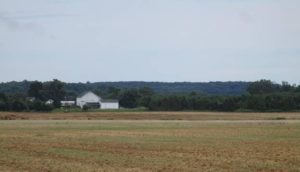
2017, August 6, Sunday — A view of the cuesta from the Union Transportation Trail in Upper Freehold, Monmouth County. The view is looking toward the Shore, so the abrupt rise in the terrain is seen. From the other side of the cuesta, the change in terrain is more gradual.
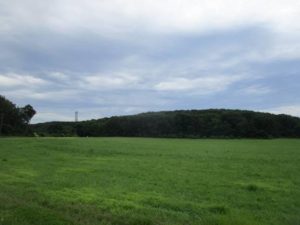 2017, August 6, Sunday — Another view of the cuesta – here, near the Horse Park of New Jersey in Upper Freehold, Monmouth County.
2017, August 6, Sunday — Another view of the cuesta – here, near the Horse Park of New Jersey in Upper Freehold, Monmouth County.

2016, January – Looking at the cuesta, about 200 feet above sea level, across Sandy Hook Bay from Sandy Hook.
BUTTERFLIES IN THE ZINNIA PATCH: Last year, my newspaper reporting travels took me to Bobby Laurino’s farm market in Colts Neck and Andy Capelli’s farm market in Middletown. I was amazed by the bees and butterflies attracted to their zinnia patches. Here was this abundance of pollinators and they were fun to watch. So, I did some research on zinnia – liking it because it is an annual, not a perennial I would be stuck with – and planted it in my garden, about 35 to 40 row feet. I wish I planted more! In recent days, I have spotted these butterflies: painted lady, “Vanessa cardui”; spicebush swallowtail, “Papilio troilus”; cabbage white, “Pieris rapae”; silver-spotted skipper, “Epargyreus clarus”; and monarch, “Danaus plexippus.” I try to become one with the zinnia patch, or at least letting the butterflies do their thing and me doing my thing, which allows me to get close to them and take great photographs.
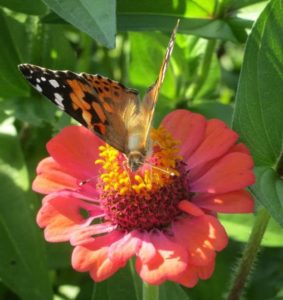
A painted lady butterfly in my zinnias.
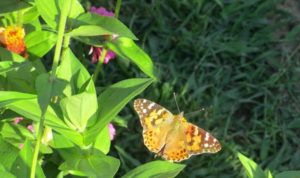
Painted lady in the zinnias.

Painted lady on a zinnia.
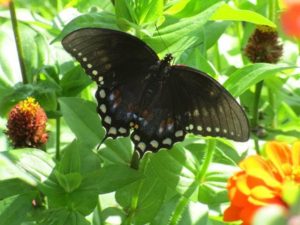
Spicebush swallowtail in the zinnias.
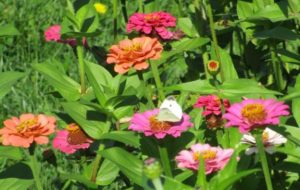 Cabbage white in the zinnias.
Cabbage white in the zinnias.
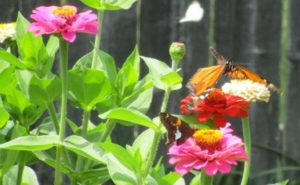
Silver-spotted skipper, lower, and monarch, upper, in the zinnias.
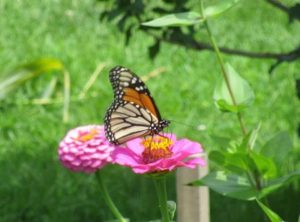
Monarch in the zinnias.
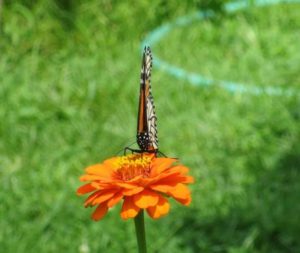
Monarch on a zinnia.
SOURCES, BUTTERFLIES: I love this Internet site of the North American Butterfly Association (NABA)-North Jersey Butterfly Club for identifying butterflies, http://www.naba.org/chapters/nabanj/butterflies.html.
GARDEN VOICE NO. 1, DEBBIE MANS: Debbie Mans reported, “We were just comparing notes at work on our gardens and we are all not seeing great results — split tomatoes, fizzled squash, slow on the tomatoes ripening, etc. This is in Monmouth County and Essex County. I am hearing more and more from others, too. You are not alone!” (Debbie is executive director and baykeeper for the New York-New Jersey Baykeeper environmental group based in Keyport, Monmouth County. Here is a profile I wrote of Debbie last year, http://tworivertimes.com/debbie-mans-midwesterner-with-jersey-sand-in-her-shoes/.)
NAVESINK RIVER BOAT RIDE: Debbie Mans’s New York-New Jersey Baykeeper group is sponsoring a Navesink River boat ride September 19, Tuesday, out of Atlantic Highlands, Monmouth County. Last year, I sailed with the Baykeeper on a Sunday afternoon on Raritan Bay and the Shrewsbury River – a great time! So, if free, consider the Navesink River ride. Monmouth County’s Navesink River, one of my favorite places in the Jersey Midlands as it flows along the cuesta emptying into the Shrewsbury River. For the Navesink River Sunset Eco Cruise.
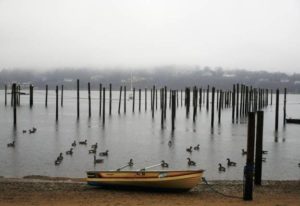
2015, December – Along the Navesink River.
GARDEN VOICE NO. 2, JACK MAHON: South Jersey gardener Jack Mahon and I recycle dehumidifier water, using it for gardening watering. But, this year, both Jack and I have noticed something – the heavy rains have left us with an overabundance of water. “The rain has been so heavy at times that the dehumidifier is way ahead of the trees’s need for water,” Jack said. Ditto. In recent days, my two barrels of water for the garden, totaling 50 gallons, have been full.
IN THE GARDEN AND YARD: I continued harvesting flowers, both zinnias and Knock Out roses, along with sweet corn. The fall crop is sprouting. And I watch the cucumbers and cantaloupe, hoping something comes about. The cantaloupes look OK as they grow, but the cucumbers seem to be victims of too much rain and I wonder if I will even get one to use.
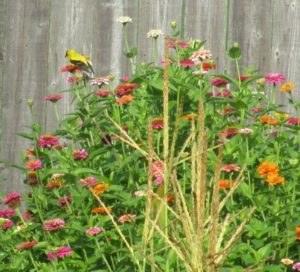
A male Eastern goldfinch, “Spinus tristis,” perched on a zinnia flower in the garden.
MONROE TOWNSHIP COMMUNITY GARDEN: I visited my lifelong hometown’s Community Garden and Park. It is a nice setting along the Millstone River. But I wish Monroe, which continues to develop heavily, would practice greener principles. For example, abandon magazine-photograph lawns and replace them with more productive organic gardens. Me, I am trying to go with as little lawn as possible – and my lawn is chemical-free. I know, I strive for an Old Monroe in a New Monroe whose population over its approximately 42 square miles is an estimated 45,000, a big difference from the estimated 5,000 when I was born in 1956.
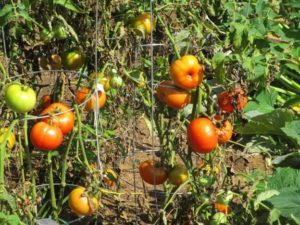
Tomatoes in the Monroe Community Garden and Park.
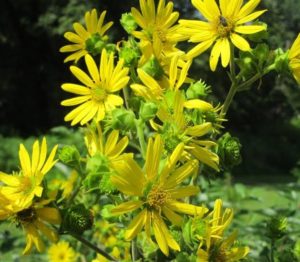
Flowers at the Monroe Community Garden and Park.
THE ECLIPSE OF THE SUN: On Monday, August 21, New Jersey will be treated to a partial solar eclipse. It begins at 1:22 p.m., peaks at 2:44 p.m., and ends at 4 p.m. DO NOT LOOK AT THE ECLIPSE UNLESS YOU HAVE SPECIAL PROTECTIVE EYEWEAR. (While I find the eclipse exciting, I do not want to take chances of looking up. So, I will take a nap, work in my cellar or garage, or follow the eclipse on the computer or television.) See https://eclipse2017.nasa.gov/.
CARDINAL PHOTO: The photo of a cardinal, “Cardinalis cardinalis,” in last week’s “Garden and Afield” drew a nice response from backyard neighbor Fran D’Aiello Rosuck. Fran and her husband, Ed, have been my family’s neighbor for about 40 years, or since about the time I went on my own after college. Then, after my parents, Joe Sapia Sr. and Sophie Onda Sapia, died, I, as an only child, moved back and took over the house. This summer, the outside of the house was remodeled. Fran said, “I always read that a cardinal is a visitor from Heaven. Your mom is probably saying the house never looked so good.” What a nice comment to find on my “The Jersey Midlands” page on Facebook.com.
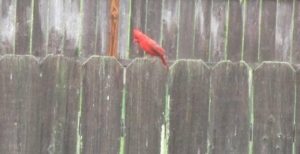
The cardinal at my garden. Actually, it is on backyard neighbor Fran D’Aiello Rosuck’s fence.
OCEAN TEMPERATURES: Atlantic Ocean temperatures on the New Jersey coast were in the range of about 75 to 77 degrees.
SUNRISE/SUNSET: For August 20, Sunday, to August 26, Saturday, the sun will rise about 6:15 to 6:20 a.m. and set about 7:40 to 7:50 p.m. For August 27, Sunday, to September 2, Saturday, the sun will rise about 6:20 to 6:25 a.m. and set about 7:30 p.m.
WEATHER: The National Weather Service forecasting station for the area is at http://www.weather.gov/phi/.
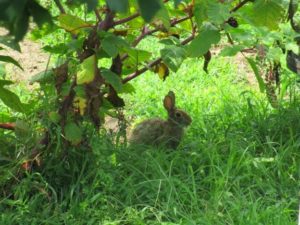 Rabbit, genus “Sylvilagus,” in the garden.
Rabbit, genus “Sylvilagus,” in the garden.
Joe Sapia, 60, is a lifelong Monroe resident. He is a Pine Barrens naturalist and an organic vegetable-fruit gardener. He gardens the same backyard plot as did his Italian-American father, Joe Sr., and his Polish-immigrant, maternal grandmother, Annie Poznanski Onda. Both are inspirations for his food gardening. Joe is active with the Rutgers University Master Gardeners/Middlesex County program. He draws inspiration on the Pine Barrens around Helmetta from his mother, Sophie Onda Sapia, who lived her whole life in these Pines, and his Grandma Annie. Joe’s work also is at @JosephSapia on Twitter.com, along with Facebook.com on the Jersey Midlands page.
Article and photos by Joe Sapia
Note: The yard references are to my house in the section of Monroe between Helmetta and Jamesburg in South Middlesex County. My yard is in a Pine Barrens outlier on the Inner Coastal Plain, the soil is loamy, and my neighborhood is on the boundary of Gardening Zones 6b (cooler) and 7a (warmer). Notes and photographs are for the period covered, unless otherwise noted.
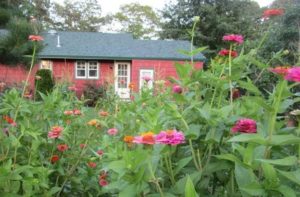
Looking across my backyard garden to the Knock Out roses and the house.
IN THE GARDEN: I began harvesting sweet corn – it tastes so good! I continued harvesting zinnia, mostly giving them away. Because zinnia are so beautiful, make nice bouquet gifts, and are so attractive to pollinators, I plan to really expand on growing them next year, taking over what is now a waste of lawn. I finished planting seeds for fall crops of beets, carrots, lettuce, and peas. Including early season, summer and fall crops, my garden is about 450 row feet. I began keeping a record of my harvest, so I have an idea how productive the garden actually is. Next year, I plan to keep the record from Day 1 harvest to Last Day harvest.
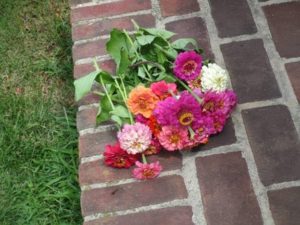
A zinnia bouquet heading to friends at my Sunday lunch stop, the Hightstown Diner.
A BAD GARDENING YEAR: I thought my garden was bombing out because of my lack of skills, but I continue to get reports of it not being a productive vegetable year. Paul Migut, a childhood friend and a gardening mentor of mine, checked in from South River, Middlesex County: “Agree, not one of the best garden years, here either.” Jack Mangano of Helmetta told me his family’s plot is not doing as good as it should. The weather has been fickle, one day monsooning, another day sunny and in the 90s – seemingly more fickle than a normal Jersey hot and humid summer with thunderstorms in the afternoon. I found a split cucumber, which, I suspect, was a victim of the rain – the rain forcing it to grow faster than it was able to maintain, resulting in it finally bursting.
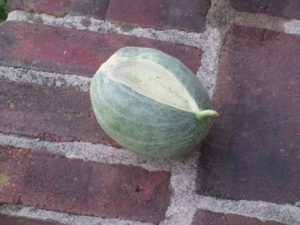
A split and ill-forming cucumber, an apparent victim of too much rain.
GARDENING TALK: Paul Migut reported on his garden: “Bush beans producing the best. Cucumbers growing well (made second batch of dill pickles in my grandmother’s 100-year-old old crock). Rutgers tomatoes getting bigger, but still green. Yellow (acid-free) almost ready to pick. Eggplants, too small to pick. Zucchini started out with a bang, until worm/borer devoured base of plant. By accident, I purchased a packet of turnip seeds, never grew these before, but wow- growing very well!”
ELSEWHERE AROUND THE YARD: I took off from feeding the birds this summer, letting them, instead, eat insects in the yard and serve as natural pesticides. So, I have not kept the eye I normally do on birds, mesmerized by them at the feeder. However, I did notice a bright yellow and black (male) Eastern goldfinch, “Spinus tristis”; a bright red (male) cardinal, “Cardinalis cardinalis”; and a favorite, a catbird, “Dumetella carolinensis” – the catbirds that keep me company in garden and afield. The toads are around, presumably helping control insects. I helped a toad out of a deep well of cellar window that was recently installed. I place a branch in the well; If a toad goes in, hopefully it can crawl out on the branch – because by the time I notice it, it may be too late. Of course, the friendly rabbits are around – letting me get close and probably eating up the garden. And the Knock Out roses, in their second bloom of the season, are getting better and better.
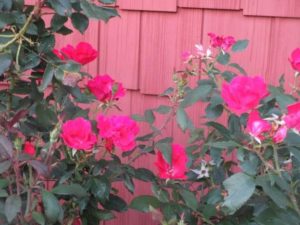
Knock Out roses are blooming beautifully in their second bloom of the season.
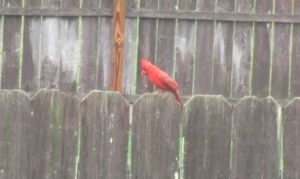
A male cardinal perched by the garden. A male, because it is bright red. The female is a dull brown.
ATTRACTING POLLINATORS, ZINNIA: While I love the beauty and no-fuss growing of zinnias, my real goal for planting them this year was to attract pollinators. This week, pollinators were around:

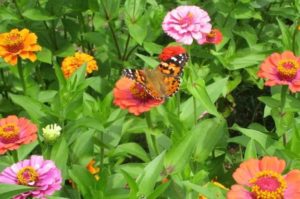
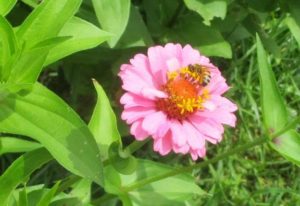
PERSEID METEOR SHOWER: The forecasted weather is not looking good, but take a chance and look up into the night sky on the overnights of August 11-12, Friday-Saturday, or August 12-13, Saturday-Sunday, the peak of the annual Perseid Meteor Shower. If there is a clear sky, an estimated 40 to 50 “shooting stars” will be visible per hour. The Earth will continue passing through Comet Swift-Tuttle’s path until August 24. See www.space.com/32868-perseid-meteor-shower-guide.html.
THE DRIVE-BY NATURALIST, ROADKILL: I was driving south on Route 539 in East Windsor, Mercer County, heading for the Assunpink Wildlife Management Area, when I came across an interesting sight -– vultures, both turkey, “Cathartes aura”, and black, “Coragyps atratus,” eating a roadkill deer, “Odocoileus virginianus.” It was an interesting study in nature, the death of one animal providing life-support to other wildlife. But it also was an interesting interaction between wildlife and humans – basically, traffic had to avoid the vultures, rather than the vultures making a serious attempt to avoid traffic. What did I take away from this scene? The importance of us helping living wildlife by moving dead wildlife off the roadway, because other birds may not be so lucky squaring off against traffic at a roadkill. A live bird could end up as roadkill.
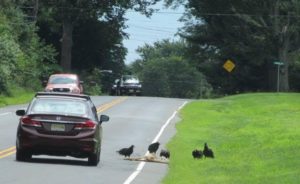
Notice how traffic has to move to avoid the vultures, while the vultures generally were carefree.
DRIVE-BY NATURALIST, NO. 2 – TURKEY VULTURES VS. BLACK VULTURES: Turkey vulture, red head, long tail. Black vulture, black head, short tail. (Note: I do not recall seeing a black vulture locally until probably the 1990s. They are a southern species that has moved northward.)
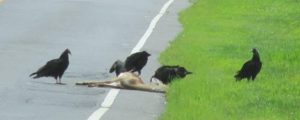
Turkey vulture, far left, with a red head and longer tail. Black vulture, far right, with short tail and black head.
CONNECTING WILDLIFE HABITAT: The state Department of Environmental Protection’s Endangered and Nongame Species Program has been working on a project, CHANJ, or Connecting Habitat Across New Jersey, which is aimed at creating wildlife habitat connectivity, since about 2012. The plan is to make a public push in 2018. CHANJ is looking to protecting habitat and connecting habitat through such things as land purchase, management of land, and safe wildlife passage at roadways. Roadway mitigation could include using culverts and bridges to have a safe pathway for wildlife to cross roads. The idea is have connectivity using core areas, which could be as little as 200 acres to as big as state regions such as the Highlands of North Jersey and, locally, the Pine Barrens. Core is “an area with high ecological integrity,” said Gretchen Fowles, a CHANJ biologist. “That’s a fancy way of saying it has little human influence,” she said. In Monmouth County, for example, beside the Pine Barrens as a region, CHANJ looks at cores as such places as the Navesink River, Manasquan River Reservoir, Shark River, Allaire State Park, the Turkey Swamp state- and county-owned properties, Monmouth Battlefield State Park, and Assunpink Wildlife Management Area. Then, the idea is to connect such areas as forest, field, freshwater wetlands, and coastal maritime habitats. “This might be kind of a last chance to keep areas protected and intact,” Fowles said. The CHANJ website is at http://www.state.nj.us/dep/fgw/ensp/chanj.htm. Also, a CHANJ video is at https://www.youtube.com/watch?v=6UbBcTUfz1U.
MUSHROOMS: Remember the adage, “There are old mushroom pickers. There are bold mushroom pickers. There are NO old AND bold mushroom pickers.” Me, 60-years-old, lifelong Jersey Midlands, from a maternal Polish-Slovak family of pickers going back here more than 100 years and I will comfortably pick only 2 mushroom species: honey (or “opienki,” as my Polski side calls them), genus “Armillaria,” and morels genus “Morchella.” My confidence in only those 2 comes from being taught by two smart, non-bold pickers. Because this time of year is popular for wild mushrooms: http://www.philly.com/philly/health/n-j-mushroom-poisonings-spike-some-potentially-life-threatening-20170808.html
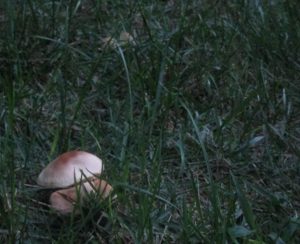
Inedible mushrooms in my yard.
“FALL” FOLIAGE: In the Pine Barrens around Helmetta, the beginning of the “fall” foliage usually is obvious in swamps beginning about July 15 to July 31. So, no surprise I have seen a few examples.
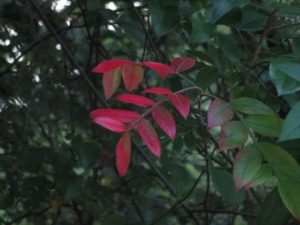
Changing colors in the Helmetta Pond wetlands.
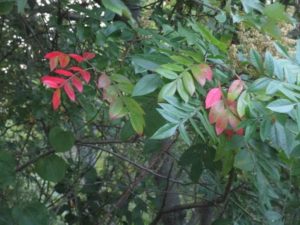
Another view of the changing colors in the Helmetta wetlands.
OCEAN TEMPERATURES: Atlantic Ocean temperatures on the New Jersey coast were in the range of about 76 to 78 degrees Thursday, August 10.
UPCOMING COUNTY FAIRS: Middlesex County Fair concludes August 13, Sunday, in East Brunswick, http://middlesexcountyfair.com/. Hunterdon County 4-H and Agricultural Fair, August 23, Wednesday, to August 27, Sunday, http://www.hunterdoncountyfair.com/.
OTHER UPCOMING: August 21, Monday, solar eclipse. September 9 and 10, Saturday and Sunday, 10 a.m. to 5 p.m., the state Department of Environmental Protection’s Wild Outdoor Expo at the Colliers Mills Wildlife Management Area, Jackson, Ocean County, WildOutdoorExpo.com.
SUNRISE/SUNSET: For Aug. 13, Sunday, to August 19, Saturday, the sun will rise about 6:05 to 6:15 a.m. and set about 7:50 p.m. to 7:55 p.m. For August 20, Sunday, to August 26, Saturday, the sun will rise about 6:15 to 6:20 a.m. and set about 7:40 to 7:50 p.m.
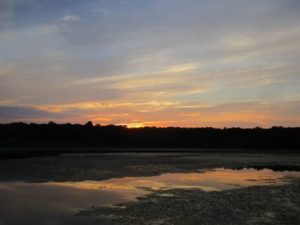
Sunset at Helmetta Pond.
WEATHER: The National Weather Service forecasting station for the area is at http://www.weather.gov/phi/.
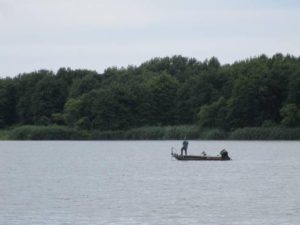
Assunpink at the Assunpink Wildlife Management Area, here in Monmouth County
Joe Sapia, 60, is a lifelong Monroe resident. He is a Pine Barrens naturalist and an organic vegetable-fruit gardener. He gardens the same backyard plot as did his Italian-American father, Joe Sr., and his Polish-immigrant, maternal grandmother, Annie Poznanski Onda. Both are inspirations for his food gardening. Joe is active with the Rutgers University Master Gardeners/Middlesex County program. He draws inspiration on the Pine Barrens around Helmetta from his mother, Sophie Onda Sapia, who lived her whole life in these Pines, and his Grandma Annie.
Joe’s work also is at @JosephSapia on Twitter.com, along with Facebook.com on the Jersey Midlands page.
Article and photos by Joe Sapia, except as noted
Note: The yard references are to my house in the section of Monroe between Helmetta and Jamesburg in South Middlesex County. My yard is in a Pine Barrens outlier on the Inner Coastal Plain, the soil is loamy, and my neighborhood is on the boundary of Gardening Zones 6b (cooler) and 7a (warmer). Notes and photographs are for the period covered, unless otherwise noted.

This scene, on August 2, Wednesday, at the Sears department store in New Brunswick, Middlesex County, kind of sums up this summer’s weather: alternating pouring rain and blue sky.
FARRINGTON LAKE: I love kayaking Farrington Lake on the boundary of South Brunswick, North Brunswick, and East Brunswick, all in Middlesex County. It is slender, about 3-1/2 miles long. Because there is so much forest lining the shores, it has a feel of being in the Adirondacks or some other place that is remote, rather than on the edge of suburbia as it is. This week, I did not kayak, but simply stopped to grab some quick photographs. Of course, the lake, created by the damming of Lawrence Brook basically between Davidson Mill Pond Park and Milltown, is beautiful, but I also saw a beautiful flower, purple loosestrife, “Lythrum salicaria.” The problem is purple loosestrife is non-native, highly invasive species, clogging the wetlands ecosystem. On the bright side, I was entertained by swallows. They fluttered around the lake, searching for bugs to eat.
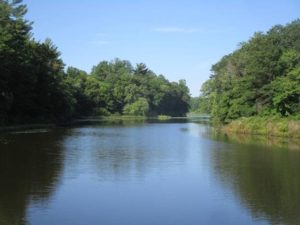
Farrington Lake, looking south toward Route 130 from the Church Lane bridge.
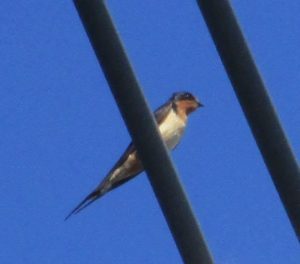
A barn swallow, “Hirundo rustica,” perches on a utility line above Farrington Lake.
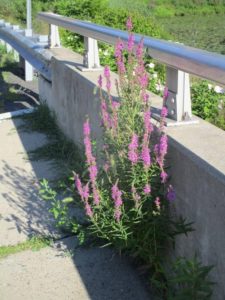
Purple loosestrife, even coming up through a crack in the sidewalk on the Church Lane bridge crossing Farrington Lake.
IN THE GARDEN: Cucumbers, cantaloupe, sweet corn, and tomatillos continue to grow, not yet ready to harvest. Remember me mentioning how I did not plant the tomatillos? Well, now, the garden is sprouting what appears to be gourds, which I did not plant. The zinnias continue to bloom wonderfully. And looking to the fall, I planted carrots. I went to Tony’s Farm and Garden Center in Robbinsville, Mercer County, and picked up more seeds for a fall crop: Detroit Red Medium Top Beets, Touchon Heirloom Carrots, Sugar Snappy Peas, Sugar Daddy Heirloom Peas, and Snowbird Peas, all Burpee brand.
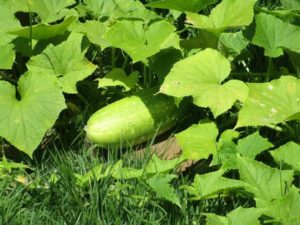
Here come the cucumbers. I place a brick underneath the cukes and mushmelons to keep them from having contact with the ground, leading to rot.
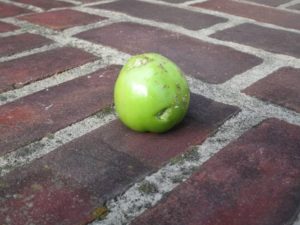
Which one of my yard friends bit into this green tomato?
GARDEN TALK: While at Tony’s Farm and Garden Center, I got talking to Tony Ciacco, the third generation of the Ciacco family to own and run the center. Tony mentioned the lack of bees in the environment, as we stood in amidst rows of flowers. Among those flowers, few, if any bees, which act as pollinators, flew around. In the past, the center would warn customers of bees flying around its greenhouses, Tony said. Later that afternoon, neighbor Tom DeRose and I stood in my zinnia patch. The zinnia patch noticeably has butterflies moving from flower to flower, but hardly any bees. We are in real trouble if we measure pollination by bees. Tom also mentioned his garden is having a bad year for carrots with a lot of green but little fruit. My carrots, too, are not doing great – some with clusters of nice carrots, some with lots of green but not good carrot production.
COLOR AT TONY’S: When I go to Tony’s Farm and Garden Center, I try to shoot photos because there is a lot of color in the plantlife.
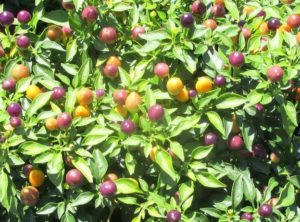
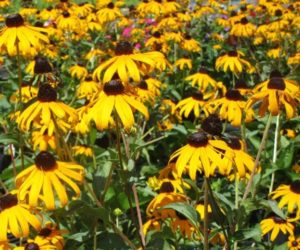
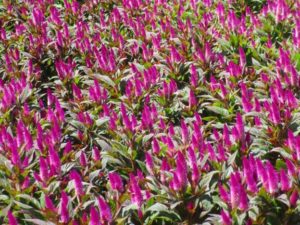
BALD EAGLES: I got a report of bald eagles, “Haliaeetus leucocephalus,” having a nest this season along the Raritan River just north of downtown New Brunswick. Also, the state Department of Environmental Protection confirmed a nest, which fledged one chick, in my hometown of Monroe. So, I have been keeping an eye out for eagles flying around near that nest, which is in the area of Route 33 and Applegarth Road/Butcher Road.
ORCHIDS IN THE PINE BARRENS: Faye Bray, a friend and outdoorswoman who lives in the main Pine Barrens, comes through again with beautiful reports of orchids. This time, the white-fringed, “Habernaria blephariglottis,” and the yellow-fringed, “Habernaria ciliaris.” Both were found recently in the Oswego Lake, Burlington County, area of the main Pine Barrens.
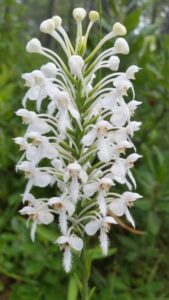
White-fringed orchid in the Oswego Lake area, Burlington County, of the Pine Barrens. (Photo copyright 2017 by Faye Bray.)
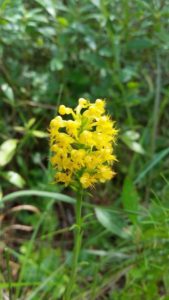
Yellow-fringed orchid in the Oswego Lake area of the Pine Barrens. (Photo copyright 2017 by Faye Bray.)
LOW MOISTURE IN THE AIR: When I am out in the garden, or the yard in general, I try to observe the world around me – basically the woods around me, The Swamp down the street, and the sky. As for the sky, on July 30, Sunday, Joey Slezak, a meteorologist and my go-to science guy in Helmetta, texted me, “Bluebird skies this morning! Low humidity!” Yes, the sky had that clear look to it because moisture was not clogging up the air. A great day to do yard work. I texted back, “Going out to cut lawn, camera in hand.” On days such as this, it feels as though one could reach up and touch airplanes passing by.

A JetBlue Airbus cruises by at about 240 knots at approximately 4,800 feet on its way from Fort Lauderdale, Florida, to Newark, Essex County. (How do I know the details on this aircraft? From following my new obsession, www.flightradar24.com.)
OBSESSION, NO. 2, WATERING THE GARDEN: In recent days, I have gone from daily watering (except when for days when it is raining) to more sporadic watering. If nothing else, I was worried the cantaloupe and sweet corn were getting too much water, especially because of the recent rain.
GRANDMA’S WATERING CANS: Normally, I water the garden using house water with hose and sprinkler. When I accumulate enough water in my water barrels, which can hold 20 gallons and 30 gallons, I use sprinkling cans I had around the house. At least one of them is Grandma Annie Onda’s. The other one, if not Grandma’s, was Ma and Pops’s. Those watering cans must date to the 1960s or earlier. One of them has a pretty severe leak. But they are still being put to good use. (Grandma, Ma, and Pops are deceased — Grandma in 1972, Ma in 1995, and Pops in 2006 — but their implements around the house are still being used by me.
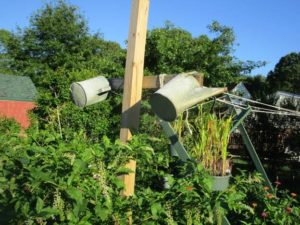
The old watering cans.
MORE WATERING WAYS: Jack Mahon – a South Jersey gardener, naturalist, and birder – shared his watering ways: “First, basement de-humidifier drains to bucket in sink. Milk jugs are filled from bucket. If we’re away, I just let it (the dehumidifier) drain directly into the sink. Next, jugs on back deck. Some have white caps, some pink. The pink ones would have a very diluted liquid plant food that I use in the first half of the season. Right now, though, they are 100 percent water. At end of August, I’ll start another very weak fertilizer routine, phosphorus & potash rather than the spring nitrogen-based. Finally, four of the crop, American beech, crepe myrtle, black pine, and willow oak. I only bother with hardy varieties that can overwinter in a cold frame.”
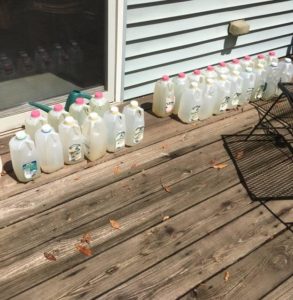
Jack Mahon’s recycled de-humidifier water to be used for potted trees he is raising. White caps mean pure water. Pink caps mean water diluted with plant food. (Photos supplied by Jack Mahon.)
BOOKS FOR THE JERSEY MIDLANDS NATURALIST, NO. 2: Years ago, I picked up a valuable book at New Jersey Audubon’s Owl Haven nature center at Monmouth Battlefield State Park in Monmouth County – “New Jersey Wild Plants” by Mary Y. Hough, a plant ecologist and taxonomist, 1983, Harmony Press, Harmony, N.J. The book lists plantlife alphabetically by its scientific name. So, most of us probably would need to use another source using common names, then check Mary’s book. As Rutgers University botanist David E. Fairbrothers wrote in the book’s preface, “This publication was designed as a New Jersey supplement for current field guides and technical manuals. …Included are all native and introduced species of club mosses, conifers, ferns, flowering plants, horsetails, quillworts, and spikemosses growing without cultivation in the state. …It is indeed a welcome addition for professional and non-professional biologists and/or naturalists, because it provides information about species for the entire state, much of which is not available or scattered in many sources, because of a lack of a “Manual of the Flora of New Jersey.” Mary Hough deserves our appreciation for having produced a useful information source about the interesting flora of a very floristic geographical area….” What I love about this book is it tells New Jersey bloom times, lists habitat and general state locations for finding the species, and gives a tidbit of more information such as the plant being poisonous or a little of the history in finding the plantlife. Owl Haven is long gone, but Hough’s book still proves invaluable. It is one of the most-used books in my outdoors collection. (Note: One, books mentioned in this series may be out of print. Two, Dr. Fairbrothers, now deceased, was a very informative and kind mentor of my pursuits in the Spotswood Outlier of the Pine Barrens.)
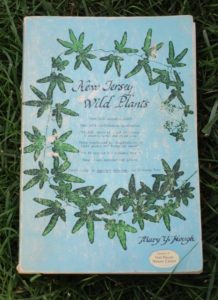
Mary Y. Hough’s “New Jersey Wild Plants”

Y. Hough’s “New Jersey Wild Plants.” Here, the listings for sheep laurel, “Kalmia angustifolia,” and mountain laurel, “Kalmia latifolia.”
MUSHROOMS: I have seen some chatter regarding the edibility of mushrooms on a Pine Barrens Facebook page I follow. I am 60-years-old and lifelong Jersey Midlands and I feel comfortable picking only two types of mushrooms. I will not identify them for this conversation because I do not want to confuse anyone on what is edible. So my basic advice, only feel safe eating a locally found mushroom if a COMPETENT picker OKs it. Remember the adage: “There are old mushroom pickers. There are bold mushroom pickers. There are no old AND bold mushroom pickers.”
CLOUDS: Over the last several months, we have been blessed with beautiful views of cloudy skies…
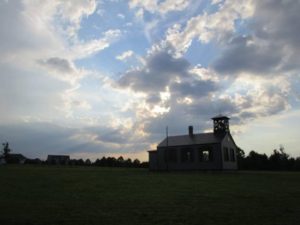
At the Dey Farm Historic Site in Monroe.
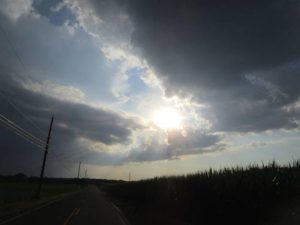
Farmland at the Applegarth section of Monroe.

At the Johnson and Johnson clock tower in New Brunswick.
IN THE YARD, ROSES: There seems to be a sporadic, but beautiful, bloom on the “Knock Out” roses in my backyard. So, I will call this a continuation of the second bloom of the season, rather than a third bloom. The rose bushes did get somewhat battered during the recent outside remodeling of my house that lasted from mid-June to late July. Perhaps that is the reason for sporadic blooming.
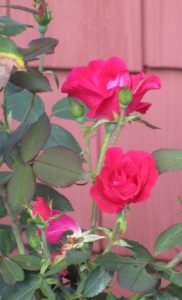
The “Knock Out” roses in bloom in the backyard.
OCEAN TEMPERATURES: Atlantic Ocean temperatures on the New Jersey coast were in the range of 73 to 76 degrees on Saturday, August 5.
UPCOMING COUNTY FAIRS: Middlesex County Fair, August 7, Monday, to August 13, Sunday, in East Brunswick, http://middlesexcountyfair.com/. Somerset County 4-H Fair, August 9, Wednesday, to August 11, Friday, in Bridgewater, http://www.somersetcounty4h.org/fair/. Hunterdon County 4-H and Agricultural Fair, August 23, Wednesday, to August 27, Sunday.
OTHER UPCOMING: There will be a solar eclipse August 21, Monday.
SUNRISE/SUNSET: For Aug. 6, Sunday, to August 12, Saturday, the sun will rise at about 6 to 6:05 a.m. and set about 8 to 8:05 p.m.
WEATHER: The National Weather Service forecasting station for the area is at http://www.weather.gov/phi/.
JOEY’S WORLD: On Saturday, August 5, I found one of my garden buckets filled with water and thought, When did it rain hard? But neighbor Tom DeRose informed me the neighborhood had a severe thunderstorm after midnight and before dawn. We did? Oh, boy, I must have pretty much slept through it.
SCREEN TENT: A few weeks back, I ordered a Coleman screen tent. I wanted a simple way to enjoy the backyard without mosquitoes biting me. I had to wait for the remodeling contractors to be gone, before I could regain control of my yard, including putting up the tent. What a buy for about $60 or so dollars. I did write much of this blog in the tent. Now, to find more time to enjoy the tent.
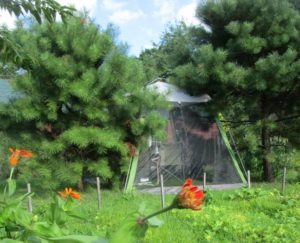
The screen tent nestled between two pitch pines, “Pinus rigida,” the food-flower garden, and lawn.
A PLAN FOR NEXT YEAR: Simply, as little lawn as possible. Translated, more space for growing food and zinnias, less grass for me to cut.
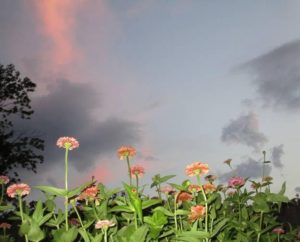
Beautiful zinnias in the garden and a beautiful sky in the background.
Joe Sapia, 60, is a lifelong Monroe resident. He is a Pine Barrens naturalist and an organic vegetable-fruit gardener. He gardens the same backyard plot as did his Italian-American father, Joe Sr., and his Polish-immigrant, maternal grandmother, Annie Poznanski Onda. Both are inspirations for his food gardening. Joe is active with the Rutgers University Master Gardeners/Middlesex County program. He draws inspiration on the Pine Barrens around Helmetta from his mother, Sophie Onda Sapia, who lived her whole life in these Pines, and his Grandma Annie. Joe’s work also is at @JosephSapia on Twitter.com, along with Facebook.com on the Jersey Midlands page. Copyright 2017 by Joseph Sapia
Article and photos by Joe Mish
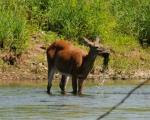

Dining at the underwater salad bar, this deer enjoys more than a mouthful of greenery, obtained by submerging its face in the water up to its ears.
August is a deep relaxing stillness in the never-ending cycle of renewable life. It is the moment after the final brush stoke is applied to an artistic masterpiece. Work that began anew, a year before, has reached a higher level of maturity in an infinite succession of seasonal effort.
The terminal end of each season can be a time of reflection, as an endpoint immediately prompts the thought of a beginning. August, however, is different, as there is an aura of timelessness created in an extended moment of satisfying exhalation; an arrival after a long journey.
Time is now suspended by desire. August is the moment we want to last. There is no desire for summer to end or feel the chill of winter sooner than scheduled. Mentally we drag our feet to slow the calendar, even assigning 31 days isn’t enough, and in response, time accelerates.
While the berries harvests of June and July have gone by, the plants that sent their energy to the fruit, now direct it to the roots and leaves in preparation for next berry season. The berry season may have been the highpoint for berry consumers but for the blackberry or dewberry plant, August is a finish line in a race to recover and maximize growth for next year’s crop.
The dark green leaves and vegetation, that dominate the high summer landscape, are noticeably different than the array of green tints seen in the spring. It is as if colors went through a maturation process independent of natural influences. Where the palest greens began to darken in color, as each successive tint accumulated, until it reached a deep forest green.
The summer greenery is not limited to plants and leaves dancing in the wind. Beneath the surface of the river, underwater grasses have reached maturity by late summer. In clear shallow water, the fast current animates long strands of flowing grasses, isolated in bundles across sections of sandy river bottom. Dark green grass sways alongside pony tails of Kelly green and gray green grass to cast a hypnotic spell on a passing paddler.
Deer relish these grasses and spend many a high summer day, faces submerged, full to their ears, in an effort to enjoy that cool mixed salad.
Blooming raspberry colored thistle, topped with flocks of hungry yellow goldfinch, teasel, goldenrod, strands of deep purple pokeweed berries and off-white Queen Anne’s lace, act as colorful bejeweled timepieces set among the greenery of August. Listen closely and you can even hear the ticking of that seasonal clock as black walnuts begin drop. The ticking is especially loud and shocking when a plum sized black walnut falls into quiet water on a calm, windless day, to spike a paddler’s heart rate.
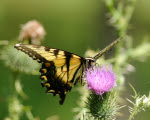
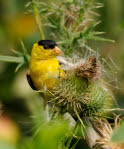
Goldfinch and tiger swallow-tail feed on the blooming thistle of late summer.
August can hardly keep a secret as it reveals a preview of things to come. Look closely and you can find isolated flashes of red and orange staghorn sumac, poison ivy and Virginia creeper. Even if you miss the visual clues, August provides an occasional chilly morning as a reminder that its moment of stillness is just an illusion.
The gold of August is revealed by its first two letters, au, the symbol for gold and awarded for achievement. The ‘gust’ or gusto represents the vigor of mature life that peaks in high summer.
Author Joe Mish has been running wild in New Jersey since childhood when he found ways to escape his mother’s watchful eyes. He continues to trek the swamps, rivers and thickets seeking to share, with the residents and visitors, all of the state’s natural beauty hidden within full view. To read more of his writing and view more of his gorgeous photographs visit Winter Bear Rising, his wordpress blog. Joe’s series “Nature on the Raritan, Hidden in Plain View” runs monthly as part of the LRWP “Voices of the Watershed” series. Writing and photos used with permission from the author.




















































































































